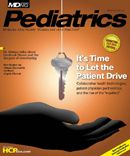The Net Guide: Cystic Fibrosis
The Educated PatientCystic Fibrosis: Diet and Nutrition
Having to eat high-fat, high-calorie foods just to maintain a healthy weight may seem like an easy task for most teenagers, but as this KidsHealth.org site points out, that isn’t always the case. Here, children and adolescents with cystic fibrosis (CF) can learn how the disease affects the body, what nutrients they need, and in what foods they might find them. Included are recipes for high-calorie foods, tips on how to add calories to foods (such as drinking whole milk and topping salads with avocadoes), and information about vitamin supplements, tube feedings, and enzyme supplements.
Link code: k8324
Medical WebsitesNewborn Screening for Cystic Fibrosis
Visit this site to access recommenda¬tions from the CDC on the screening of newborns for cystic fibrosis (CF) and on how to effectively implement screening programs for states that choose to routinely screen newborns for CF. The report, which includes “an evaluation of the benefits and risks of this type of screening,” is based on research findings and peer-reviewed evidence presented at a workshop cosponsored by the CDC and the Cystic Fibrosis Foundation. The comprehensive report includes background information on the rare disease—including genetics, pathophysiology, and natural history; information on diagnosis and treatment, screening protocols and algorithms, benefits of screening in terms of growth and nutrition, cognitive development, hospitalization, survival, pulmonary status, and health-related quality of life, and information on the risks involved.
Link code: x8315
Online CMEAhead of the Curve: Emerging CF TherapiesCredits: 2.00
Fee: None
Expires: March 15, 2012
Multimedia: None
Based on presentations given during the 23rd Annual North American Cystic Fibrosis Conference, this educational activity will focus on the most current understanding of the pathophysiology underlying cystic fibrosis (CF), potential therapeutic targets of current clinical research, known data regarding ongoing research into CF transmembrane conductance regulator modulation, and current research regarding salt transport/correcting ion transport, P2Y2 agonists, and epithelial sodium channel antagonists.
Link code: x8336
Celebrating a Half-Century of Advances in Cystic FibrosisCredits: 1.00
Fee: None
Expires: March 12, 2011
Multimedia: Audio/video
In this Pediatric Grand Rounds webcast, Phillip M. Farrell, MD, of the University of Wisconsin School of Medicine and Public Health, will discuss the major diagnostic and therapeutic advances in cystic fibrosis (CF) of the pancreas in the context of its unique historical progression and the pivotal value of early diagnosis and the principles of newborn screening. Farrell will also describe how insights were gained on the pathophysiology of CF and how they were applied to devise new therapies.
Link code: x8337
Clinical TrialsExercise-Induced Bronchospasm in Cystic FibrosisStudy Type: Observational
Age/Gender Requirements: 12 years (male/female)
Sponsor: Ohio State University
Purpose: To determine how often exercise-induced bronchospam occurs in cystic fibrosis and how it may impact those with the disease. In three visits, subjects will perform pulmonary function testing before and after bronchodilators, eucapnic voluntary hyperventilation, and cardiopulmonary exercise testing followed by serial spirometry.
Link code: k8367
Studying Patients with Cystic Fibrosis and Other Pulmonary and Pancreatic DisordersStudy Type: Observational
Age/Gender Requirements: 4 years (male/female)
Sponsor: National Institute of Diabetes and Digestive and Kidney Diseases (NIDDK)
Purpose: This long-term, large-scale study is designed to increase understanding of the natural history, clinical presentation, and genetics of cystic fibrosis (cystic fibrosis), and “provide patients with information on the prognosis of the disease as well as recommendations for management” of CF.
Link code: k8368
eAbstractsMealtime Interactions in Families of a Child with Cystic Fibrosis: A Meta-analysisJournal: Journal of Cystic Fibrosis (September 2010)
Authors: Hammons AJ, Fiese B
Purpose: To examine differences in family mealtimes between families with and without a child with cystic fibrosis (CF) by comparing global measures of family functioning during the mealtime and parent-child micro behaviors specific to feeding in order to determine if one class of mealtime behaviors is more strongly affected.
Results: Researchers found that “families with children with CF encounter more difficulties during mealtimes than comparison families, and the effects on overall family functioning are greater than for parent-child micro feeding behaviors.”
Link code: k8357
Psychosocial Consequences of False-Positive Newborn Screens for Cystic FibrosisJournal: Qualitative Health Research (September 2010)
Authors: Tluczek A, Orland KM, Cavanagh L, et al
Purpose: To establish a framework for understanding parents’ perspectives about the psychosocial consequences of false-positive newborn screening (NBS) results for cystic fibrosis (CF) by analyzing interviews with 87 parents of 44 infants.
Results: “Abnormal NBS results that involve genetic testing can have psychosocial consequences that affect entire families,” they found. “These findings merit additional investigation of long-term psychosocial sequelae for false-positive results, interventions to reduce adverse iatrogenic outcomes, and the relevance of the relational family system framework to other genetic testing.”
Link code: k8358
Pharma Focus
Pulmozyme (Dornase Alfa)
Clinical TrialsPulmozyme in Cystic Fibrosis with SinusitisStudy Type: Interventional
Age/Gender Requirements: 12-65 years (male/female)
Sponsor: Penn State University
Purpose: To determine whether “intranasal use of Pulmozyme will decrease the severity of sinusitis in patients with cystic fibrosis and lead to an improved quality of life.”
Link code: k8369
eAbstractsA Technical Feasibility Study of Dornase Alfa Delivery with Eflow Vibrating Membrane Nebulizers: Aerosol Characteristics and Physicochemical StabilityJournal: Journal of Pharmaceutical Sciences (June 2010)
Authors: Scherer T, Geller DE, Owyang L, et al
Purpose: To ascertain the feasibility of using perforated vibrating membrane devices to deliver the dornase alfa—an inhaled mucus-active drug—three independent laboratories studied aerosol characteristics, nebulization time, dose delivery, and stability of dornase alfa following nebulization.
Results: The studies determined that “the eFlow vibrating membrane technology delivers dornase alfa more rapidly and efficiently than jet nebulizers, and does not affect the physicochemical properties of the drug. These results demonstrate “only the technical feasibility of using vibrating membrane devices to deliver dornase alfa”—further studies are required to determine the safety and efficacy of these drug-device combinations for cystic fibrosis.
Link Code: k8359
